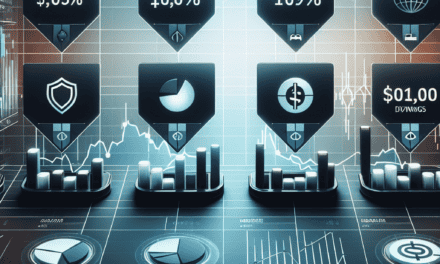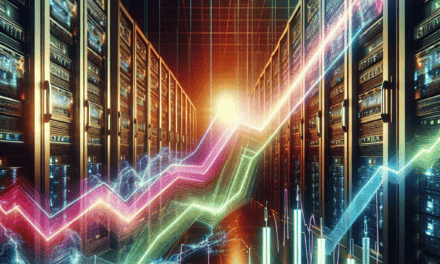“SolarEdge Stumbles: Shares Dive Over 20% on Gloomy Forecast and Costly Writedown”
Introduction
SolarEdge Technologies, a prominent player in the solar energy sector, recently experienced a significant decline in its stock value, with shares plummeting over 20%. This sharp drop followed the company’s release of a disappointing financial forecast, which fell short of market expectations. Additionally, SolarEdge announced a substantial writedown, further exacerbating investor concerns. The combination of these factors has raised questions about the company’s future growth prospects and its ability to navigate the increasingly competitive renewable energy landscape. As a result, stakeholders are closely monitoring how SolarEdge plans to address these challenges and restore confidence in its financial performance.
Impact Of SolarEdge’s Forecast On The Renewable Energy Market
SolarEdge Technologies, a prominent player in the renewable energy sector, recently experienced a significant decline in its stock value, with shares plummeting over 20%. This sharp drop was primarily triggered by a disappointing financial forecast and a substantial writedown, sending ripples through the renewable energy market. As investors and industry stakeholders grapple with the implications of this development, it is crucial to understand the broader impact on the renewable energy landscape.
To begin with, SolarEdge’s revised forecast has raised concerns about the company’s future growth prospects. The company, known for its innovative solar inverters and energy management solutions, has been a key contributor to the advancement of solar technology. However, the recent forecast suggests a slowdown in demand, which could be attributed to various factors, including market saturation in certain regions and increased competition from other renewable energy firms. This has led to apprehensions about SolarEdge’s ability to maintain its competitive edge and sustain its growth trajectory.
Moreover, the writedown announced by SolarEdge has further exacerbated investor anxiety. A writedown typically indicates that a company has overestimated the value of its assets, leading to a reduction in their reported worth. In SolarEdge’s case, this writedown reflects challenges in accurately assessing the value of its inventory and other assets, which may be influenced by fluctuating market conditions and evolving technological trends. Consequently, this has raised questions about the company’s financial health and its capacity to navigate the complexities of the renewable energy market.
The impact of SolarEdge’s forecast and writedown extends beyond the company itself, affecting the renewable energy sector as a whole. As a leading player in the industry, SolarEdge’s performance is often seen as a barometer for the health of the solar energy market. Therefore, its recent struggles have sparked concerns about the overall stability and growth potential of the renewable energy sector. Investors, who have been increasingly drawn to renewable energy stocks due to their potential for long-term growth and sustainability, may now exercise caution, leading to a potential slowdown in investment inflows.
Furthermore, the situation underscores the challenges faced by renewable energy companies in an ever-evolving market. As technological advancements continue to reshape the industry, companies must remain agile and innovative to stay ahead of the competition. SolarEdge’s predicament serves as a reminder of the importance of strategic planning and adaptability in navigating the complexities of the renewable energy landscape. Companies that fail to anticipate market shifts and adjust their strategies accordingly may find themselves at a disadvantage, as evidenced by SolarEdge’s recent struggles.
In addition, the broader implications of SolarEdge’s forecast and writedown highlight the need for continued support and investment in renewable energy. Despite the challenges faced by individual companies, the transition to clean energy remains a critical global priority. Policymakers and industry leaders must work collaboratively to create an environment conducive to innovation and growth in the renewable energy sector. This includes fostering research and development, providing financial incentives, and implementing policies that encourage the adoption of clean energy technologies.
In conclusion, the recent plunge in SolarEdge’s shares serves as a wake-up call for the renewable energy market, emphasizing the need for vigilance and adaptability in an ever-changing landscape. While the company’s disappointing forecast and writedown have raised concerns, they also present an opportunity for reflection and strategic realignment. As the renewable energy sector continues to evolve, stakeholders must remain committed to fostering innovation and resilience, ensuring a sustainable and prosperous future for clean energy.
Analyzing The Financial Implications Of SolarEdge’s Writedown
SolarEdge Technologies, a prominent player in the solar energy sector, recently experienced a significant decline in its stock value, with shares plummeting over 20%. This sharp drop followed the company’s announcement of a disappointing financial forecast and a substantial writedown. Investors and analysts alike are now scrutinizing the financial implications of these developments, as they could have far-reaching consequences for the company’s future performance and market position.
To begin with, the disappointing forecast issued by SolarEdge has raised concerns about the company’s growth prospects. The solar industry, while burgeoning, is highly competitive and subject to various external pressures, including fluctuating government policies, technological advancements, and changing consumer preferences. SolarEdge’s revised forecast suggests that the company may be struggling to maintain its competitive edge in this dynamic environment. This has understandably led to a loss of investor confidence, as evidenced by the steep decline in share prices.
Moreover, the writedown announced by SolarEdge is a critical factor contributing to the current financial predicament. A writedown typically indicates that a company has overestimated the value of its assets, necessitating a reduction in their reported value. In SolarEdge’s case, this writedown could be indicative of underlying issues, such as overinvestment in certain technologies or markets that have not yielded the expected returns. This not only impacts the company’s balance sheet but also raises questions about its strategic decision-making processes.
The financial implications of the writedown are multifaceted. Firstly, it directly affects SolarEdge’s profitability, as the reduction in asset value translates to a decrease in net income. This, in turn, can lead to a lower return on investment for shareholders, further eroding investor confidence. Additionally, the writedown may necessitate a reevaluation of the company’s capital allocation strategies. SolarEdge may need to redirect resources towards more promising ventures or technologies to regain its footing in the market.
Furthermore, the combination of a disappointing forecast and a significant writedown could have implications for SolarEdge’s ability to secure financing. Lenders and investors often view such developments as red flags, potentially leading to higher borrowing costs or more stringent lending terms. This could constrain the company’s financial flexibility, limiting its ability to invest in research and development or expand its market presence.
In light of these challenges, SolarEdge must take decisive action to address the concerns raised by its recent financial disclosures. This may involve reassessing its strategic priorities, optimizing its operational efficiency, and enhancing its risk management practices. By doing so, the company can work towards restoring investor confidence and stabilizing its financial position.
In conclusion, the recent plunge in SolarEdge’s share value, driven by a disappointing forecast and a substantial writedown, underscores the financial challenges facing the company. The implications of these developments are significant, affecting profitability, capital allocation, and financing capabilities. As SolarEdge navigates this turbulent period, its ability to adapt and respond effectively will be crucial in determining its future trajectory in the competitive solar energy market.
Investor Reactions To SolarEdge’s Share Price Decline
SolarEdge Technologies, a prominent player in the solar energy sector, recently experienced a significant decline in its share price, plummeting over 20% following a disappointing financial forecast and a substantial writedown. This sharp drop has sparked a wave of reactions among investors, who are now grappling with the implications of these developments on their portfolios and the broader market sentiment. The company’s recent announcement has raised concerns about its future performance, prompting investors to reassess their positions and strategies.
The primary catalyst for the decline in SolarEdge’s share price was the company’s revised financial outlook, which fell short of market expectations. Investors were particularly disheartened by the company’s lowered revenue projections, which suggested a slowdown in growth. This unexpected revision has led to a reevaluation of SolarEdge’s growth prospects, as investors weigh the potential impact of these forecasts on the company’s long-term trajectory. The market’s reaction underscores the sensitivity of stock prices to forward-looking statements, especially in industries characterized by rapid technological advancements and competitive pressures.
In addition to the disappointing forecast, SolarEdge announced a significant writedown, further exacerbating investor concerns. The writedown, which pertains to certain assets that have lost value, signals potential challenges in the company’s operational efficiency and asset management. This development has prompted investors to question the underlying factors contributing to the writedown and its implications for SolarEdge’s financial health. As a result, there is heightened scrutiny on the company’s management team and their ability to navigate these challenges effectively.
The reaction from investors has been varied, with some opting to divest their holdings in response to the negative news, while others view the dip as a buying opportunity. Those in the latter camp argue that the current share price may not fully reflect SolarEdge’s intrinsic value, considering its established position in the renewable energy sector and its potential for future growth. However, this perspective is tempered by the uncertainty surrounding the company’s ability to address the issues highlighted in its recent announcements.
Moreover, the broader market context cannot be ignored, as the renewable energy sector is subject to a range of external factors, including regulatory changes, technological advancements, and shifts in consumer demand. These dynamics add an additional layer of complexity to investors’ decision-making processes, as they must consider how these factors might influence SolarEdge’s performance in the coming months and years.
In light of these developments, analysts and investors alike are closely monitoring SolarEdge’s next moves, particularly any strategic initiatives aimed at mitigating the impact of the forecast and writedown. The company’s ability to restore investor confidence will likely hinge on its capacity to demonstrate resilience and adaptability in the face of these challenges. As the situation unfolds, it remains to be seen how SolarEdge will navigate this turbulent period and what strategies it will employ to regain its footing in the market.
In conclusion, the recent plunge in SolarEdge’s share price has elicited a range of reactions from investors, reflecting the complexities and uncertainties inherent in the renewable energy sector. While some view the decline as a temporary setback, others remain cautious, awaiting further clarity on the company’s strategic direction. As SolarEdge works to address the issues at hand, its actions will be closely scrutinized by investors seeking to understand the long-term implications of these developments on their investment portfolios.
Future Prospects For SolarEdge After The Recent Market Setback
SolarEdge Technologies, a prominent player in the solar energy sector, recently experienced a significant market setback as its shares plunged over 20%. This dramatic decline followed the company’s announcement of a disappointing forecast and a substantial writedown, which have raised concerns about its future prospects. As investors and industry analysts assess the implications of these developments, it is crucial to explore the factors contributing to this downturn and the potential pathways for SolarEdge moving forward.
The recent forecast issued by SolarEdge has been a primary catalyst for the sharp decline in its stock value. The company projected lower-than-expected revenue growth, citing challenges such as supply chain disruptions and fluctuating demand in key markets. These issues have been exacerbated by broader economic uncertainties, including inflationary pressures and geopolitical tensions, which have collectively dampened investor confidence. Consequently, the market’s reaction underscores the sensitivity of SolarEdge’s financial performance to external variables, highlighting the need for strategic adjustments to navigate these turbulent times.
In addition to the disappointing forecast, SolarEdge’s decision to undertake a significant writedown has further compounded investor concerns. The writedown, primarily related to inventory and certain assets, reflects the company’s reassessment of its current market position and future growth potential. While such financial adjustments are not uncommon in the industry, the scale of the writedown has raised questions about SolarEdge’s operational efficiency and its ability to adapt to evolving market dynamics. This development has prompted a reevaluation of the company’s strategic priorities, with a focus on optimizing its supply chain and enhancing its product offerings to better align with market demands.
Despite these challenges, SolarEdge remains a key player in the renewable energy sector, with a robust portfolio of innovative technologies and a strong global presence. The company’s commitment to advancing solar energy solutions positions it well to capitalize on the growing demand for clean energy, driven by increasing environmental awareness and supportive government policies. However, to fully realize its potential, SolarEdge must address the underlying issues that have contributed to its recent market setback. This includes strengthening its supply chain resilience, diversifying its product range, and expanding its market reach to mitigate the impact of regional fluctuations.
Moreover, SolarEdge’s future prospects will be influenced by its ability to leverage emerging trends in the renewable energy landscape. The transition towards decentralized energy systems and the integration of energy storage solutions present significant opportunities for growth. By investing in research and development, SolarEdge can enhance its technological capabilities and offer comprehensive solutions that cater to the evolving needs of consumers and businesses alike. Additionally, strategic partnerships and collaborations with other industry leaders can facilitate access to new markets and drive innovation, further bolstering the company’s competitive edge.
In conclusion, while the recent market setback has undoubtedly posed challenges for SolarEdge, it also presents an opportunity for the company to reassess its strategies and strengthen its position in the renewable energy sector. By addressing the immediate concerns related to its forecast and writedown, and by capitalizing on emerging trends and opportunities, SolarEdge can navigate the current uncertainties and pave the way for sustainable growth. As the global demand for clean energy continues to rise, SolarEdge’s ability to adapt and innovate will be crucial in shaping its future trajectory and maintaining its leadership in the industry.
Lessons Learned From SolarEdge’s Disappointing Financial Forecast
SolarEdge Technologies, a prominent player in the solar energy sector, recently experienced a significant decline in its stock value, with shares plummeting over 20%. This sharp drop was primarily triggered by a disappointing financial forecast and a substantial writedown, which have raised concerns among investors and industry analysts alike. As the company navigates these turbulent waters, there are several lessons to be gleaned from this situation, offering valuable insights for both SolarEdge and the broader renewable energy market.
To begin with, the importance of accurate forecasting cannot be overstated. SolarEdge’s recent financial projections fell short of market expectations, leading to a loss of investor confidence. This underscores the critical need for companies to provide realistic and transparent forecasts that align closely with market conditions and internal capabilities. Inaccurate forecasts can lead to severe repercussions, as seen in SolarEdge’s case, where the discrepancy between expectations and reality resulted in a dramatic stock price decline. Therefore, companies must invest in robust forecasting models and maintain open communication with stakeholders to mitigate such risks.
Moreover, the writedown that accompanied SolarEdge’s forecast revision highlights the challenges associated with asset valuation in rapidly evolving industries. As technology advances and market dynamics shift, companies must regularly reassess the value of their assets to ensure they reflect current realities. In SolarEdge’s situation, the writedown suggests that previous valuations may have been overly optimistic or based on outdated assumptions. This serves as a reminder for businesses to adopt a proactive approach in evaluating their assets, taking into account potential market fluctuations and technological advancements.
In addition to these financial considerations, SolarEdge’s predicament also emphasizes the significance of strategic agility. The renewable energy sector is characterized by rapid innovation and changing regulatory landscapes, necessitating a flexible and adaptive approach to business strategy. Companies must be prepared to pivot and adjust their strategies in response to emerging trends and challenges. SolarEdge’s experience illustrates the potential consequences of failing to adapt swiftly to market changes, reinforcing the need for businesses to cultivate a culture of agility and responsiveness.
Furthermore, the situation at SolarEdge sheds light on the broader implications for the renewable energy industry. As the sector continues to grow and mature, companies will face increasing pressure to deliver consistent financial performance while navigating complex market dynamics. This incident serves as a cautionary tale for other players in the industry, highlighting the importance of maintaining a balance between growth ambitions and financial prudence. By learning from SolarEdge’s experience, other companies can better position themselves to weather similar challenges and sustain long-term success.
In conclusion, the recent plunge in SolarEdge’s share price offers several valuable lessons for both the company and the renewable energy sector as a whole. Accurate forecasting, diligent asset valuation, strategic agility, and financial prudence are all critical components of a successful business strategy in this rapidly evolving industry. As SolarEdge works to regain investor confidence and stabilize its financial position, these lessons will undoubtedly play a crucial role in shaping its future trajectory. By applying these insights, SolarEdge and other companies in the sector can enhance their resilience and adaptability, ultimately contributing to the continued growth and success of the renewable energy market.
Comparing SolarEdge’s Performance With Competitors In The Industry
SolarEdge Technologies, a prominent player in the solar energy sector, recently experienced a significant decline in its stock value, with shares plummeting over 20% following a disappointing financial forecast and a substantial writedown. This downturn has prompted investors and industry analysts to scrutinize SolarEdge’s performance in comparison to its competitors within the renewable energy landscape. As the solar industry continues to evolve, understanding the dynamics between key players is crucial for stakeholders aiming to navigate this rapidly changing market.
To begin with, SolarEdge has been a formidable force in the solar energy industry, known for its innovative inverter solutions that optimize the performance of solar power systems. However, the recent financial forecast, which fell short of market expectations, coupled with a significant writedown, has raised concerns about the company’s ability to maintain its competitive edge. In contrast, competitors such as Enphase Energy and First Solar have managed to sustain more stable financial performances, which has bolstered investor confidence in their respective business models.
Enphase Energy, for instance, has consistently demonstrated robust growth, driven by its microinverter technology that offers enhanced efficiency and reliability for solar installations. The company’s strategic focus on expanding its product offerings and entering new markets has allowed it to capture a significant share of the solar energy market. This approach has not only contributed to Enphase’s financial stability but has also positioned it as a formidable competitor to SolarEdge. Moreover, Enphase’s ability to adapt to changing market conditions and consumer preferences has further solidified its standing in the industry.
Similarly, First Solar, a leader in photovoltaic (PV) solar energy solutions, has maintained a strong market presence through its focus on large-scale solar projects and advanced thin-film technology. First Solar’s commitment to innovation and sustainability has enabled it to differentiate itself from competitors, including SolarEdge. The company’s strategic investments in research and development have resulted in cutting-edge solar solutions that cater to the growing demand for clean energy. Consequently, First Solar’s consistent performance and forward-looking strategies have made it a preferred choice for investors seeking stability in the renewable energy sector.
In light of these comparisons, it is evident that SolarEdge faces significant challenges in regaining its competitive position. The company’s recent financial setbacks underscore the importance of strategic agility and innovation in the solar industry. To remain competitive, SolarEdge may need to reassess its business strategies, focusing on diversifying its product portfolio and exploring new market opportunities. Additionally, enhancing operational efficiencies and investing in research and development could be pivotal in restoring investor confidence and driving future growth.
Furthermore, the broader solar industry is characterized by rapid technological advancements and evolving regulatory landscapes, which necessitate continuous adaptation by market participants. Companies that can effectively navigate these changes are likely to emerge as leaders in the renewable energy sector. As such, SolarEdge’s ability to respond to these challenges will be critical in determining its long-term success.
In conclusion, while SolarEdge’s recent financial performance has raised concerns, the company’s future prospects will largely depend on its ability to innovate and adapt to the dynamic solar energy market. By examining the strategies employed by competitors like Enphase Energy and First Solar, SolarEdge can glean valuable insights into effective market positioning and sustainable growth. Ultimately, the company’s resilience and strategic foresight will play a crucial role in shaping its trajectory within the competitive landscape of the solar industry.
Strategies For SolarEdge To Rebuild Investor Confidence
SolarEdge Technologies, a prominent player in the solar energy sector, recently experienced a significant decline in its stock value, with shares plummeting over 20%. This downturn was primarily driven by a disappointing financial forecast and a substantial writedown, which have collectively shaken investor confidence. In light of these developments, it is imperative for SolarEdge to adopt strategic measures aimed at rebuilding trust among its stakeholders and ensuring long-term stability.
To begin with, transparency in communication is crucial. SolarEdge must provide clear and comprehensive explanations regarding the factors that led to the recent financial setbacks. By openly addressing the challenges and outlining the steps being taken to mitigate them, the company can demonstrate its commitment to accountability. This transparency will not only help in managing investor expectations but also in fostering a sense of trust and reliability.
Moreover, SolarEdge should focus on strengthening its core business operations. This involves optimizing its supply chain to reduce costs and improve efficiency. By streamlining production processes and enhancing operational agility, the company can better navigate market fluctuations and maintain a competitive edge. Additionally, investing in research and development to innovate and improve product offerings will be essential. By staying at the forefront of technological advancements, SolarEdge can ensure that its products remain attractive to consumers and continue to meet the evolving demands of the solar energy market.
In parallel, diversifying revenue streams could serve as a buffer against future financial volatility. SolarEdge might consider expanding its portfolio to include complementary products or services that align with its expertise in solar technology. For instance, venturing into energy storage solutions or smart grid technologies could open new avenues for growth and provide a more stable revenue base. This diversification would not only mitigate risks associated with reliance on a single product line but also position the company as a more versatile player in the renewable energy sector.
Furthermore, strengthening partnerships and collaborations can play a pivotal role in rebuilding investor confidence. By forging alliances with other industry leaders, SolarEdge can leverage shared resources and expertise to drive innovation and market expansion. These partnerships could also facilitate entry into new geographical markets, thereby broadening the company’s customer base and enhancing its global footprint. Such strategic collaborations would signal to investors that SolarEdge is committed to growth and is actively seeking opportunities to enhance its market position.
In addition to these strategic initiatives, SolarEdge should prioritize financial prudence. This entails maintaining a robust balance sheet and ensuring adequate liquidity to weather potential economic downturns. By demonstrating fiscal responsibility and resilience, the company can reassure investors of its ability to sustain operations and pursue growth opportunities even in challenging times.
Lastly, engaging with investors through regular updates and open dialogues can help in rebuilding trust. By actively listening to investor concerns and addressing them in a timely manner, SolarEdge can foster a positive relationship with its stakeholders. This engagement will not only provide valuable insights into investor sentiment but also reinforce the company’s commitment to transparency and accountability.
In conclusion, while the recent plunge in SolarEdge’s share value poses significant challenges, it also presents an opportunity for the company to reassess its strategies and reinforce its position in the market. By focusing on transparency, operational efficiency, diversification, strategic partnerships, financial prudence, and investor engagement, SolarEdge can rebuild confidence and pave the way for sustainable growth in the future.
Q&A
1. **What caused SolarEdge shares to plunge over 20%?**
SolarEdge shares plunged over 20% due to a disappointing financial forecast and a significant writedown.
2. **What was the disappointing forecast about?**
The disappointing forecast was related to lower-than-expected revenue and profit projections for the upcoming quarters.
3. **What is a writedown, and how did it affect SolarEdge?**
A writedown is a reduction in the book value of an asset. SolarEdge’s writedown negatively impacted its financial statements, contributing to the share price decline.
4. **How did the market react to SolarEdge’s announcement?**
The market reacted negatively, with investors selling off shares, leading to a significant drop in the stock price.
5. **What are the potential implications for SolarEdge’s future performance?**
The disappointing forecast and writedown may indicate challenges in SolarEdge’s business operations, potentially affecting future growth and profitability.
6. **How did analysts respond to the news about SolarEdge?**
Analysts likely revised their ratings and price targets for SolarEdge, reflecting concerns over the company’s financial health and future prospects.
7. **What might SolarEdge do to recover from this situation?**
SolarEdge might focus on strategic initiatives to improve operational efficiency, explore new markets, or innovate its product offerings to regain investor confidence.
Conclusion
SolarEdge shares experienced a significant decline of over 20% following the company’s release of a disappointing financial forecast and a substantial writedown. This downturn reflects investor concerns about the company’s future growth prospects and financial health. The writedown indicates potential overvaluation of assets or underperformance in certain business segments, further exacerbating market apprehension. As a result, SolarEdge may face increased scrutiny from investors and analysts, necessitating strategic adjustments to restore confidence and stabilize its market position.





